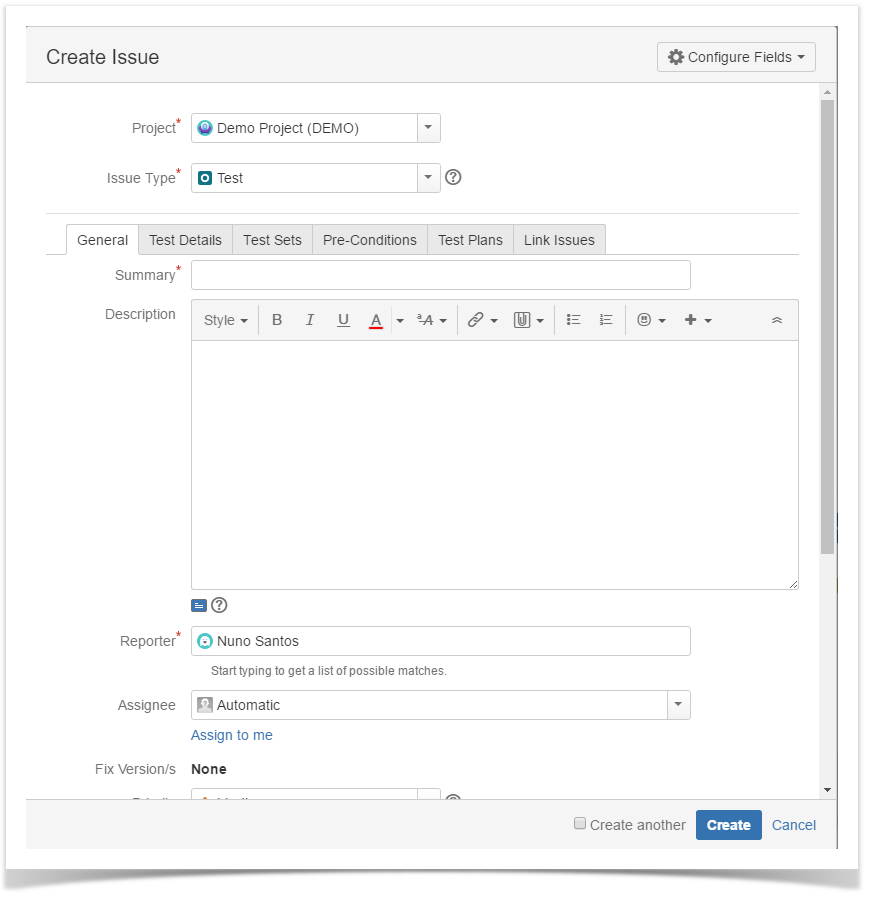TESTER STARTER
Maecenas eget tellus eget felis semper sollicitudin tempus non enim. Fusce sollicitudin porta felis, vitae consectetur elit consequat a. Vestibulum erat quam, dignissim
Using the top "Create" button"
In order to create a new Test Issue,
Step 1: Click the Create Issue at the top of the screen to open the Create Issue dialog box / page.

Step 2: Select the Project and on Issue Type, select Test.
Step 3: Under the General tab, type a Summary for the test and fill all appropriate fields — at least, the mandatory ones marked with an asterisk.

Step 4: On the Test Details tab, select the Test Type and complete all appropriate fields;
Step 4a: If you are writing a Manual Test:
- Select the Test Type as Manual.
- After filling out the Manual Steps fields, press the Add button to jump to the next Manual Step.
- Use the Pencil button to edit a previously entered Manual Step, and press the Update button when done.
- Use the Bin button to delete a previous entered Manual Step.
- To change a Manual Step position in the Test, drag the left area of the row and drop it to the desired place.

Step 4b: If you are writing a Cucumber Test:
- Select the Test Type as Cucumber.
- On Cucumber Type, select either Scenario or Scenario Outline as test type.
- On Cucumber Scenario, enter the Cucumber Scenario clauses in Gherkin.

Step 4c: If you are writing a Generic Test:
- Select the Test Type as Generic.
- On Generic Test Definition, enter the definition for the automated generic Test.

Optional:
- Click on the Test Sets tab to associate the current issue with Test Sets.
- Click on the Pre-Conditions tab to associate the current issue with Pre-Conditions.
- Click on the Test Plans tab to associate the current issue with Test Plans.
- Click on the Link Issues tab to link with other issues and specify the nature of the association.
- To create a series of similar tests – within the same Project – check the Create another box at the bottom of the dialog.
Step 5: When you are satisfied with the content of your test, click the Create button.
Step 5a: If you checked the Create another box, a new Create Issue dialog appears. This issue is automatically pre-populated with your previous test details, while leaving the Summary field blank.
Pro Tip
Lorem ipsum dolor sit amet, consectetur adipiscing elit. Vivamus imperdiet, nisl tristique consequat euismod, tortor lectus gravida mauris, quis efficitur enim nisi at ex. Proin sem nulla, commodo sed iaculis nec, eleifend id ante. Fusce finibus accumsan iaculis. Nunc auctor luctus erat, at interdum dui ultricies sit amet. Vestibulum dapibus, mauris nec lobortis interdum, urna tortor volutpat metus, vitae efficitur nunc lectus sed metus. Morbi non sapien ac dolor rhoncus luctus eu et nibh. Ut nisl risus, facilisis id velit et, pharetra suscipit purus. Curabitur vitae t
From the requirement issue screen
In order to create a new Test Issue directly from the requirement issue screen, and link it automatically to the requirement,
Step 1: Click the Create Issue at the top of the screen to open the Create Issue dialog box / page.

Step 2: Select the Project and on Issue Type make sure you have Test selected.
Step 3: Under the General tab, type a Summary for the test and fill all appropriate fields — at least, the mandatory ones marked with an asterisk.

Step 4: On the Test Details tab, select the Test Type and complete all appropriate fields;
Step 4a: If you are writing a Manual Test:
- Select the Test Type as Manual.
- After filling out the Manual Steps fields, press the Add button to jump to the next Manual Step.
- Use the Pencil button to edit a previously entered Manual Step, and press the Update button when done.
- Use the Bin button to delete a previous entered Manual Step.
- To change a Manual Step position in the Test, drag the left area of the row and drop it to the desired place.

Step 4b: If you are writing a Cucumber Test:
- Select the Test Type as Cucumber.
- On Cucumber Type, select either Scenario or Scenario Outline as test type.
- On Cucumber Scenario, enter the Cucumber Scenario clauses in Gherkin.

Step 4c: If you are writing a Generic Test:
- Select the Test Type as Generic.
- On Generic Test Definition, enter the definition for the automated generic Test.

Optional:
- Click on the Test Sets tab to associate the current issue with Test Sets.
- Click on the Pre-Conditions tab to associate the current issue with Pre-Conditions.
- Click on the Test Plans tab to associate the current issue with Test Plans.
- Click on the Link Issues tab to link with other issues and specify the nature of the association.
- To create a series of similar tests – within the same Project – check the Create another box at the bottom of the dialog.
Step 5: When you are satisfied with the content of your test, click the Create button.
Step 5a: If you checked the Create another box, a new Create Issue dialog appears. This issue is automatically pre-populated with your previous test details, while leaving the Summary field blank.
Pro Tip
Lorem ipsum dolor sit amet, consectetur adipiscing elit. Vivamus imperdiet, nisl tristique consequat euismod, tortor lectus gravida mauris, quis efficitur enim nisi at ex. Proin sem nulla, commodo sed iaculis nec, eleifend id ante. Fusce finibus accumsan iaculis. Nunc auctor luctus erat, at interdum dui ultricies sit amet. Vestibulum dapibus, mauris nec lobortis interdum, urna tortor volutpat metus, vitae efficitur nunc lectus sed metus. Morbi non sapien ac dolor rhoncus luctus eu et nibh. Ut nisl risus, facilisis id velit et, pharetra suscipit purus. Curabitur vitae t
